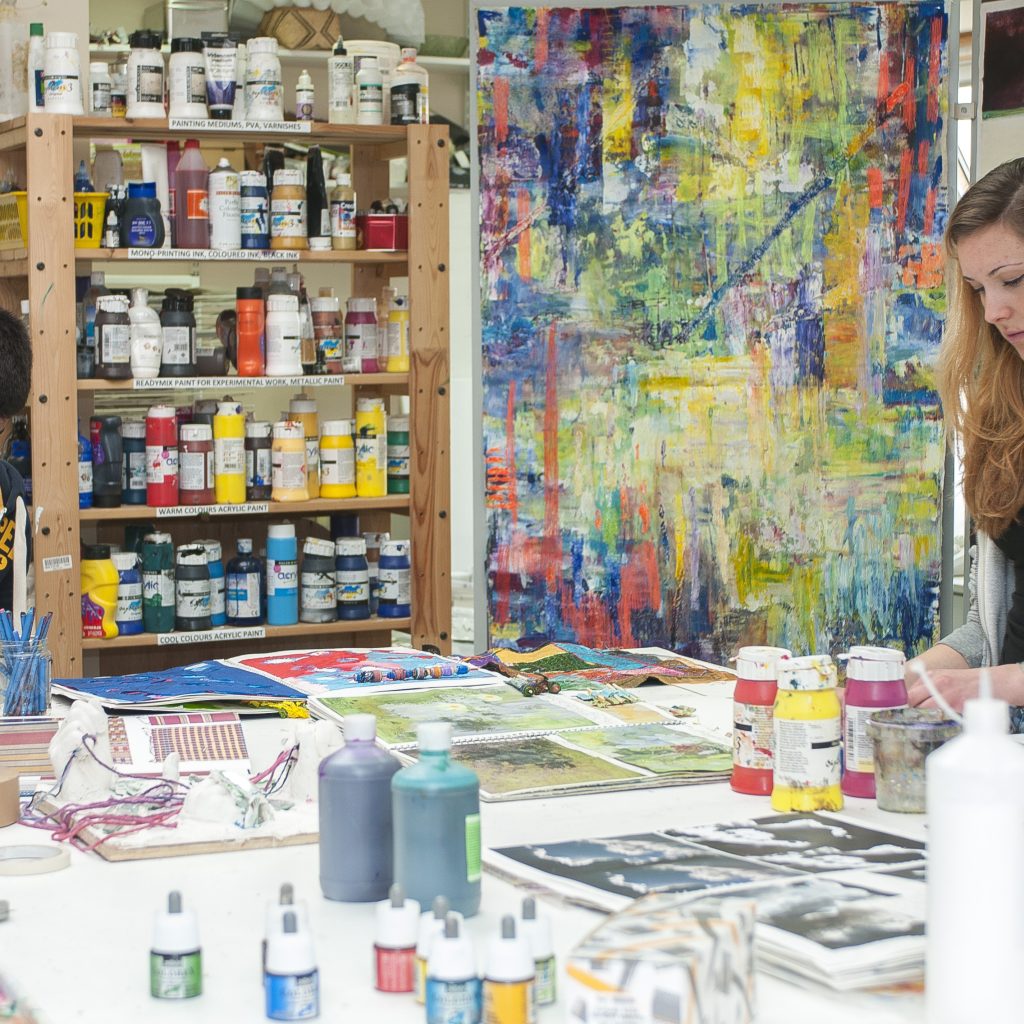We’ve all fallen victim to the Fashion world.
It’s an embarrassing, uncomfortable thought, I know. But it’s true: we’ve all been tricked into believing that we have to be keeping up with the trends, buying and discarding clothes on a regular basis.
We know that the quality is worse, but since they’re sold so cheap, we have no problem just buying another version of the exact same thing. Who can be bothered to make little repairs, right?
The term ‘fast fashion’ was introduced in the New York Times, in an article about Zara’s 15-day turnaround rate when the shop first opened in the US, in the 1980s. Zara’s plan was to introduce what was essentially a plan to pursue methods of overproduction and overconsumption — to put it simply: waste.
This plan hugely amplified the emerging culture in the 1980s of superficial materialism and disposability. Since then, with many other clothing-companies following in Zara’s footsteps, the fashion industry’s exploitative systems has led to some incredibly severe repercussions. We as consumers has almost completely separated ourselves from the very people who produce the clothes we put on every day. It is, after all, easier to live with ourselves if we don’t think about those that produce what we consider to be necessities, or indeed the environmental consequences of such rapid cycles of production. If we knew the truth, I very much doubt that, over the last 15 years, the production of clothing would have doubled globally.
If we knew the truth, we’d know that the people who suffer the most in this system are women.
The fast fashion industry was built on the breaking-backs of women — particularly women of colour, with the majority of garment workers are Asian and Southeastern women — and how they have been exploited for their labour. According to an investigation carried out by The True Cost earlier this year, 85% of garment workers employed by fast fashion corporations are women aged between 18—24, and earn, on average, less that $3 per day. What’s more, during each of these days, workers are given ridiculously high quotas to meet, per hour of work, alongside the threat that if these are not met, there would be a disturbingly high likelihood that they might not be paid at all.
You must be wondering how on earth companies could justify paying their workers so little. It’s very simple really: they don’t. Company owners and managers continue to deny this reality, while simultaneously refusing rights to their workers, who are often forced to take up accommodation in the factories’ compounds (so that they can be under constant monitoring), or locked inside the factories in which they work (so that they cannot stage walk-outs in protest, or leave before the work-day is over), or forbidden from taking toilet breaks for hours upon hours, (so that it is ensured that they meet their quotas).
These living and working conditions do not only lack in sanitation and fairness, but even in safety. In 2013, the Rana Plaza factory in Bangladesh collapsed, killing 1,138 garment workers. However, although this was nearly a decade ago, little to no changes to the industry and working conditions have been made, with the women in the supply chain still being overworked, underpaid and — overall — abused by the system.
There is such a lack of public awareness about the suffering of these workers, leading in turn to the ignorance of governmental actions and regulations to support workers in both the countries where the shops themselves are located and the ones where the garments are produced. This has meant, of course, that brands are able to continue exploiting their workers, and keep this all hidden behind closed — no, locked — doors.
The explicit misogyny extends further; gender-based violence and harassment within this sector of the fashion industry massively perpetuates this inequality.
The women who work in these factories experience harassment and violence both on their way to work (something that they fear reporting, since the fierce culture of shaming women remains in tact in these areas, as well as because the people that supervise their transits are often employed by the factory owners) and inside the factories. According to the Global Fund For Women, in Bangladesh, more than 60% of garment workers have reported that they have felt intimidated, or even threatened with violence, at work; in Cambodia, 60% of the female garment workers have said that they were made to feel uncomfortable or unsafe at work; in Vietnam, 34% of the female garment workers said that they were physically harassed within the factories, and experienced kissing, touching or hitting.
Bare in mind, of course, that these statistics are likely higher, given that these workers must have been made to feel so terrified of reporting anything, and therefore were forced to silence themselves.
This is not to say, however, that these women never try to speak up, and are not supported by other organisations. Movements across the world, such as Fashion Revolution and Re/Make work to raise awareness among the general public with campaigns like #WhoMadeMyClothes or #WearYourValues, focusing on the lives and struggles of the women behind the clothes we wear, specifically bringing up the issues of their working conditions or their low wages. These campaigns work to demand the transparency and accountability that we deserve from the large companies that dominate the fast fashion industry.
While these movements have undoubtedly played an important part in improving our understanding of these issues, it is still undeniable that these have been somewhat fuelled by the white saviour complex and biases of Western media, which often fails to show just how hard these female garment worker are trying to get their voices hears, constantly protesting and trying to unionise, in India, Bangladesh, Ghana, and many other places. These women are not letting themselves be victims. They are not waiting to be saved — especially because we are failing at helping to save them. They are fighting relentlessly for their right to higher wages and better working conditions. All they need is our support.
In Myanmar, for example, garment workers have been leading protests against the military coup, demanding the restoration of democracy, following the oppressive lockdowns and layoffs introduced during the pandemic. In fact, over the Covid-19 pandemic, it’s been estimated by the International Labour Organisation that between 600,000 and 790,000 garment workers have been impacted. Workers have been laid off, paid less, and have even had increases in their quotas. Over lockdown, I think we can all agree that we passed the time online shopping. This is the price.
It’s actually ironic in a way, how we, the people whose demands have led to the introduction of these factories, are now the ones who think we can fix everything.
But the reality, again, is that this is not exactly or wholly our fault.
We’ve been made to think that we need all these clothes. We’ve been made to forget the lives at risk in these production lines.
The executive director of the Awaj Foundation in Bangladesh, Nazma Akter, explains that “retailers colonise us due to cheap labour, exploit our youth, and disrespect the dignity of workers, especially women and girls […] It was countries that used to colonise us, now it’s large corporations.”
However, although I just mentioned that, in a way, the culpability doesn’t exactly lie with us, and that it is ultimately the companies that need to be addressed and held to account, this by no means absolves us, and of course there are steps that we must be taking.
The Global North’s waste crisis has been massively perpetuated by our culture of disposability and our expectations of fast turn-over rates. We don’t realise that, when we get rid of of our clothing, the items don’t just disappear into thin air, to be replaced and forgotten about.
One of the largest second-hand clothing supply chains is in Ghana, the second largest importer in the world. These people simultaneously have to deal with and rely on our waste — an incredibly demeaning reality.
The OR Foundation followed the lifestyles of some of the women in Kantamanto, Ghana that work as Kayayei (‘women head porters’). On a daily basis, these women carry bales of second-hand clothes on their heads, each weighing a minimum of 120lbs. For each of these trips, they’re paid on average between $0.30—$1. Considering that these bales are so heavy that carrying them often leads to long-term health issues, severe injury and sometimes even death, the fact that they receive a wage they can barely survive on clearly displays the inequality within the industry: not only are these women literally forced to carry the physical burden of the fast fashion industry, they aren’t even afforded the respect, protection or compensation for their exploitative labour.
It is, therefore, incredibly clear just how much suffering exists throughout the industry. There are of course the models, forced to maintain beauty standards at their own bodies’ expense; there are the buyers, made to feel that we must fit in with these standards and keep up with trends, whether we really like them or not; there are then the garment workers, forced to meet their quotas and produce enough items to appease the appetite of the consumer body; and then, when we’ve had enough of what we’ve bought, our disposal of the clothes simultaneously chucks away the responsibility, into the hands — or rather, onto the heads — of others. Overwhelmingly, the people who suffer the most in this chain are women.
Fast fashion is a woman’s rights issue. That’s something we can’t deny.
So next time you see the ads on your social media feeds, or the promotions in popping up in your inbox, or next time you consider buying the ridiculously underpriced, fast-fashion t-shirt with the slogan about female empowerment, remember that, in engaging with this industry, you’re exposing your ignorance, hypocrisy and all-round carelessness.
By Sarah Clif, student




